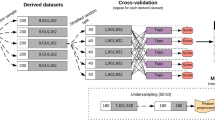Abstract
Melanoma is a very serious and lethal skin cancer. In this paper six discretization algorithms, used for preprocessing of melanoma data, were compared using criteria of rule set complexity, total number of errors, and expert’s evaluation. The best discretization method was based on divisive clustering technique. An additional experiment in which the best rules from all six rule sets, selected by an expert, were used for melanoma prediction, was additionally conducted. Our conclusion is that in the original data set, cases with suspicious melanoma were not well represented.
Access this chapter
Tax calculation will be finalised at checkout
Purchases are for personal use only
Preview
Unable to display preview. Download preview PDF.
Similar content being viewed by others
References
Bajcar, S. and Hippe, Z. S.: Risk estimate of melanoma diagnosis on the basis of assessment of dermatoscopic patterns. Proc. of the National Conference Telemedycyna, Lodz, Poland, August 17–19, 1999, 175–178.
Booker, L. B., Goldberg, D. E., and Holland, J. F.: Classifier systems and genetic algorithms. In Machine Learning. Paradigms and Methods. Carbonell, J. G. (Ed.), The MIT Press, Boston, MA, 1990, 235–282.
Chmielewski, M. R. and Grzymala-Busse, J. W.: Global discretization of continuous attributes as preprocessing for machine learning. Int. Journal of Approximate Reasoning 15 (1996) 319–331.
Friedman, R. J. Rigel, D. S., and Kopf, A. W.: Early detection of malignant melanoma: the role of physician examination and self-examination of the skin. CA Cancer J. Clin. 35 (1985) 130–151.
Grzymala-Busse, J. P., Grzymala-Busse, J. W., and Hippe, Z. S.: Melanoma prediction using data mining system LERS. Proc. of the 25th Anniversary Annual International Computer Software and Applications Conference COMPSAC 2001, Oct. 8–12, 2001, Chicago, IL, 615–620.
Grzymala-Busse, J. W.: LERS—A system for learning from examples based on rough sets. In Intelligent Decision Support. Handbook of Applications and Advances of the Rough Sets Theory. Slowinski, R. (ed.), Kluwer Academic Publishers, Dordrecht, Boston, London, 1992, 3–18.
Grzymala-Busse, J. W.: A new version of the rule induction system LERS. Fundamenta Informaticae 31 (1997) 27–39.
Grzymala-Busse, J. W. and Hippe, Z. S.: Melanoma prediction using k-Nearest Neighbor and LEM2 algorithms. Proc. of the Tenth International Symposium on Intelligent Information Systems, Zakopane, Poland, June 18–22, 2001, 43–55.
Hippe, Z. S.: Computer database NEVI on endargement by melanoma. Task Quarterly 4 (1999) 483–488.
Hippe, Z. S., Grzymala-Busse, J. W., Bajcar, S., Kinczyk, B., and Klubek, K.: A comparison of covering and induction algorithms for generation of rules identifying melanocyte changes (in Polish). Proc. of the Telemedicine Conference, September 2426, 2001, Lodz, Poland, 37–41.
Holland, J. H., Holyoak, K. J., and Nisbett, R. E.: Induction. Processes of Inference, Learning, and Discovery. The MIT Press, Boston, MA, 1986.
Pawlak, Z.: Rough Sets. International Journal of Computer and Information Sciences, 11 (1982) 341–356.
Pawlak, Z. Rough Sets. Theoretical Aspects of Reasoning about Data. Kluwer Academic Publishers, Dordrecht, Boston, London, 1991.
Quinlan, J. R.: C4.5: Programs for Machine Learning. San Mateo, CA: Morgan Kaufmann Publishers, 1993.
Rigel, D. S., Friedman, R. J., Kopf, A. W., Weltman, R., Prioleau, P. G., Safai, B., Lebwohl, M. G., Elizeri, Y., Torre, D. P., Bonford, T. T., et al.: Importance of complete cutaneous examination for the detection of malignant melanoma. J. Am. Acad. Dermatol. 14 (1986) 857–860.
Stefanowski, J.: On rough set based approaches to induction of decision rules. In Polkowski L., Skowron A. (eds.) Rough Sets in Data Mining and Knowledge Discovery. Physica Verlag, Heidelberg New York (1998) 500–529.
Author information
Authors and Affiliations
Editor information
Editors and Affiliations
Rights and permissions
Copyright information
© 2002 Springer-Verlag Berlin Heidelberg
About this paper
Cite this paper
Bajcar, S., Grzymala-Busse, J.W., Hippe, Z.S. (2002). A Comparison of Six Discretization Algorithms Used for Prediction of Melanoma. In: Kłopotek, M.A., Wierzchoń, S.T., Michalewicz, M. (eds) Intelligent Information Systems 2002. Advances in Soft Computing, vol 17. Physica, Heidelberg. https://doi.org/10.1007/978-3-7908-1777-5_1
Download citation
DOI: https://doi.org/10.1007/978-3-7908-1777-5_1
Publisher Name: Physica, Heidelberg
Print ISBN: 978-3-7908-1509-2
Online ISBN: 978-3-7908-1777-5
eBook Packages: Springer Book Archive




